US History/W Bush

2000 Election
[edit | edit source]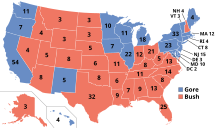
As Clinton's presidency came to a close, Democratic voters chose Al Gore, Clinton's vice president, as their nominee. Republicans chose George W. Bush, the governor of Texas and son of former President George H.W. Bush.[1]
With 25 electoral votes, Florida emerged as an important battleground state. Florida had traditionally been a Democratic-leaning state, but explosive population growth in the late nineties had brought many social and economic conservative Cubans to southern Florida.[2] The growth had left Florida very evenly split among the parties.[2]
On election night, the news media outlets first called Florida for Gore; this appeared to substantially diminish Bush's prospects for victory. This call was retracted, however, when the actual returns did not line up with the exit polls. Florida was eventually called for Bush, but this too was retracted when the vote tightened. Florida law provided for an automatic recount when votes differ by such a small margin, and when Florida decided that Bush had won, Gore sued to force further recounts in several Florida counties. Bush counter-sued, and the case went to the Supreme Court of the United States. In a 5-4 decision, the Court decided that the state of Florida must recount all the ballots in all the Florida counties and not just those for which Gore had sued, in accordance with the Equal Protection Clause of the U.S. Constitution. As Florida was required by the Florida Constitution to certify its election within days of the Court's decision, there was not enough time to recount the entire state. Thus, the final state count stood, with Bush winning Florida by 537 votes. The electoral vote was thus 271-267 in favor of Bush, who thus won the presidency despite losing the national popular vote.
Bush's First Four Years
[edit | edit source]9/11 and its Aftermath
[edit | edit source]Less than a year later, on September 11, 2001, terrorists hijacked four airline jets. At 8:46 a.m., the first plane crashed into the 110-story North Tower of the World Trade Center, and seventeen minutes later the South Tower was hit by a second plane, resulting in a huge explosion and a fire. In just two hours, both of the buildings collapsed, killing thousands, including hundreds of firefighters and police officers responding to the catastrophe. At 9:37, a third plane was flown into the Pentagon, the U.S. military headquarters in Arlington, Virginia, which sustained a huge hole in its west side. A fourth hijacked airliner crashed in Pennsylvania, perhaps as a result of resistance by the passengers. It appeared to have been heading in the direction of Washington, D.C., and its intended target is believed to have been either the U.S. Capitol building or the White House. Approximately 3000 people died in what came to be known as "9/11", making it the deadliest ever attack on the country by a foreign enemy.[3]
Responsibility for the attacks was soon attached to Osama Bin Laden, the leader of al-Qaeda, an Islamic terrorist network with training camps in Afghanistan. Bin Laden's exact grievances have been debated, but include US military presence in major Islamic nations and US support of Israel. There had been many smaller terrorist attacks aimed towards Americans by al-Qaeda before 2001, including the bombing of US embassies in Kenya and Tanzania in 1998.
The attacks, while devastating and deadly, abruptly ended the period of sharp division after the 2000 election. Many world leaders and countries expressed solidarity with the American people following the attacks.[4] Soon after the attacks, U.S. President George W. Bush declared a “war on terrorism,” warning countries that harbored terrorists would face the full power of the U.S. military. The United States charged Al Qaeda with responsibility and demanded that the Taliban turn over bin Laden and the Al Qaeda leadership, and dismantle terrorist training camps in Afghanistan. In October, the United States and Great Britain launched an attack on the Taliban and terrorists within Afghanistan. The Taliban government quickly collapsed and many Al Qaeda leaders were captured or killed, though Bin Laden would remain at large for nearly ten years. Bin Laden’s role in enabling the attacks appeared to be confirmed by videotapes in which he said that the September 11th attacks had been even more destructive than he had hoped they would be. In the weeks following September 11, a series of letter containing anthrax spores went through the mail in the United States, ultimately killing five people. No evidence was found to link the anthrax to Al Qaeda, but the anthrax scares contributed to an atmosphere of uncertainty and even panic. In response to the September 11th attacks, security has been considerably tightened on airplanes, in buildings, and in public areas. U.S. authorities detained hundreds of people whose actions or immigration status made them appear questionable, and Bush created special military tribunals that could try foreign nationals accused of terrorism. [5]
The attacks also shook the worldwide economy. Stocks tumbled when the New York Stock Exchange reopened the week following the attacks. The travel industry also declined because fewer Americans wanted to fly (due to the nature of the 9/11 attacks). In the immediate aftermath of the September 11 attacks, the United States and other countries around the world were placed on a high state of alert against potential follow-up attacks. Civilian air travel across the U.S. and Canada was — for the first time ever — almost completely suspended for three days with numerous locations and events affected by closures, postponements, cancellations, and evacuations. Other countries imposed similar security restrictions. In the United Kingdom, for instance, civilian aircraft were forbidden to fly over London for several days after the attack. Many airlines went bankrupt. A recession, following the economic boom during Bill Clinton's second term, was exacerbated by the attacks.
The World Trade Centers were occupied by a lot of firms conducting key economic activities (e.g., stock trading). As a result of the attacks the stock market began to decline. This had an impact on employment and decreased the amount of available jobs for Americans.
-
The 9/11 attacks caused a terrible loss of innocent lives.
-
Smoke pouring out of the World Trade Center, stunning New Yorkers, the Nation, and the World.
-
The collapse of the towers released a large cloud of debris on New York City.
-
Debris from the collapse caused extensive damage to surrounding areas.
-
A fireman yelling for rescue workers.
-
Debris from Flight 77 at the Pentagon.
-
The Flight 93 crash site in Pennsylvania.
-
Missing persons flyers in the aftermath of the attacks.
-
Sympathy display in November of 2001 in remembrance of the victims and those affected by their loss.
The War on Terror
[edit | edit source]
Directly following the September 11th attacks, Congress drafted and overwhelmingly passed the USA PATRIOT Act, which was signed into law on October 26, 2001. The law, while forcing citizens to forfeit some rights, strengthened the government's ability to gather information and convict suspected terrorists. Hundreds of accused terrorists have been charged and approximately half have been convicted. There have, however, been reports of abuse of the law, which went under reexamination by Congress in 2005.
In response to the attacks, the United States declared a symbolic war on terrorism. The first target in the war was Afghanistan, where the Taliban government was believed to be hiding Bin Laden and al-Qaeda. After the Taliban refused to turn Bin Laden over, American and British forces began bombing strategic Taliban centers on October 7. The invasion was swift, and major fighting had ended by the middle of 2002. The Taliban government was eliminated, and the Afghanis soon participated in their first democratic processes in many years.
In his 2002 State of the Union address, Bush named Iraq, Iran, and North Korea as a part of the "Axis of Evil," a phrase he partially coined from the World War II Axis Powers. President Bush specifically named these three countries because they were all described as rogue states, either fostering terrorists or trying to obtain nuclear weapons.
The successful invasion of Afghanistan was the first time that the newly adopted Bush Doctrine had been carried out. The Bush Doctrine stated that there was no difference between a terrorist and one who fosters a terrorist, and that the U.S. would practice pre-emptive strikes against perceived threats to American security (acting alone if needed), as it was the United States' duty to spread freedom and democracy to the rest of the world.
War in Iraq
[edit | edit source]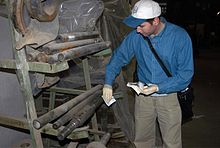
In the middle of 2002, the United Nations began focusing its attention on Iraq, as American and international intelligence agencies had intelligence indicating that Iraq possessed a number of Weapons of Mass Destruction (WMD), as well as the ongoing capacity to produce them. The United Nations Security Council passed Resolution 1441, requiring Iraq to open up to U.N. weapons inspectors or else face "serious consequences." Two of the veto-wielding members (France and Russia) of the Security Council did not wish to use military force against Iraq, and promised to veto any resolution ordering such force.
As a result to a perceived security threat verified by intelligence (which has now been found to have been unreliable), President Bush and a number of allies, deemed by the President as the "coalition of the willing," began the invasion without U.N. sanction. On the night of March 17, 2003, President Bush gave Hussein and his two sons, Uday and Qusay, an ultimatum to leave Iraq in 48 hours or face an invasion. They refused. After the expiration of the deadline given by the President, the invasion of Iraq began. The invasion lasted only a short time, and the Iraqi government and military collapsed within three weeks.
Uday and Qusay Hussein were killed in a firefight with U.S. forces in July. Saddam Hussein was found in a spider-hole and captured on December 13. Weapons of Mass Destruction were never located in Iraq. Continued suicide bombings and the ongoing American casualties led to a steady decline in American popular support for the war.
The invasion of Iraq is considered by many to mark the end of the political unity following the September 11th attacks. Although both the public and Congress favored going to war by overwhelming majorities, a substantial minority expressed reservations about invading. Many feared that the administration lacked a plan for rebuilding once the war was over. Still others worried that an invasion would alienate U.S. allies. On February 15, just one month before the invasion commenced, millions protested worldwide, including hundreds of thousands in 150 U.S. cities.
Gay Marriage
[edit | edit source]Another key issue of the 2004 election was same-sex marriage.[6] On November 18, 2003, the Massachusetts Supreme Court ruled that the banning of gay marriage is unconstitutional, thereby allowing gay marriage in that state. Following the Massachusetts ruling, California, Vermont, Maine, Hawaii, New Jersey, the District of Columbia, and Connecticut allowed for same-sex civil unions, reciprocal benefits, or domestic partnerships. In February 2004, President Bush called for a constitutional amendment defining marriage as between a man and a woman. The Senate looked into the issue, but only a minority supported the provision, while a two thirds majority is needed to pass an amendment in Congress. "The union of a man and a woman is the most enduring human institution, honored and encouraged in all cultures and by every religious faith," President Bush said. "Marriage cannot be severed from its cultural, religious and natural roots without weakening the good influence of society."[7]
The gay rights movement took a major hit on Election Day, when seven states (Georgia, Arkansas, Michigan, North Dakota, Kentucky, Oklahoma, and Utah) made it unconstitutional for marriage, civil unions, or domestic partnerships between same-sex couples. Three more (Oregon, Mississippi, and Montana) made it illegal only for homosexuals to marry, and one more (Ohio) passed an amendment illegalizing any benefits whatsoever for homosexual couples.
2004 Election
[edit | edit source]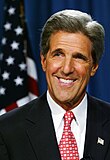
As the incumbent, Bush was unopposed for the 2004 Republican nomination. On the Democratic side, presumed favorites Hillary Clinton and Al Gore both declined to run. With the field wide open, ten Democrats sought their party's nomination. Former Vermont governor Howard Dean emerged as the front-runner, and received Gore's endorsement. However, Massachusetts senator John F. Kerry managed to win the Iowa Caucus, and rode the momentum from there.
Kerry chose North Carolina Senator John Edwards, ostensibly the Democratic candidate who received second place in terms of delegates, as his running mate. Kerry was recognized as a liberal Senator - he openly supported gay rights and same sex civil unions, was pro-choice and supported embryonic stem cell research, and opposed drilling in Alaska for oil. The Bush campaign targeted Kerry as a "flip-flopper," a term coined by the campaign to indicate that the Senator from Massachusetts changed his position constantly. The flip-flopping label was directed particularly toward Kerry's positions on the war in Iraq. In regard to a bill that passed the United States Senate providing $87 billion in funding to the war, Senator Kerry made the remark that "I actually voted for the eighty-seven billion - before I voted against it." The Bush campaign took advantage of this remark and used it as the epicenter of their flip-flopping campaign against the Senator.

With Bush and Kerry running close in the polls, it appeared that the election might come down to Florida or Ohio. Bush won both, widening his margin of victory in Florida this time around. As there appeared to be no doubt about the outcome, Kerry conceded on the following day. The final electoral vote total was 286 for Bush and 251 for Kerry (with one Minnesota elector casting a ballot for John Edwards for both President and Vice President). Additionally, Republicans strengthened their hold in both houses of Congress, particularly increasing their majority in the Senate to 55-44. The strengthening of the control of the Senate would be important to the Republicans in the following year.
The Start of a New Term
[edit | edit source]Social Security
[edit | edit source]Created in 1935, Social Security OASDI is a government program that provides most seniors with a steady income based on the real value of their prior earnings, funded by a 6.2% tax on each workers' pay and and on each employers' payrolls. Surpluses are held in Treasury securities in special Trust Funds which are credited with interest. The surplus is projected by government actuaries to peak around 2018 or 2019 and then to decline until the Trust Funds are exhausted in sometime between 2042 and 2052.
In the latter part of his first term and in his 2004 campaign, Bush focused on the issue of Social Security, and how to prevent its bankruptcy. He proposed a plan to have young workers set up stock funds which might turn out to produce better retirement benefits than OASDI but would not solve the system deficits. Many experts expect that the only long-term solution is a tax increase of about 2 percent of payroll, or a government subsidy of the same size.
Cabinet Replacements
[edit | edit source]At the start of his second term, Bush's cabinet saw significant changes. Colin Powell departed as Secretary of State, replaced by National Security Advisor Condoleeza Rice, the first African American female to hold the position. Alberto Gonzales replaced John Ashcroft as attorney general the first Mexican American to hold this post. Tom Ridge, former Governor and Vietnam War hero, also resigned from the post of Secretary of Homeland Security. Michael Chertoff, a Justice Department official, took his place.
The Double Vacancy on the Supreme Court
[edit | edit source]
In October, 2004, William H. Rehnquist was diagnosed with thyroid cancer. In July, 2005, he informed the press that he would remain on the Court as long as his health permitted.
Despite all expectations, Sandra Day O'Connor ended up being the first member of the Court to retire. Prior to O'Connor's retirement, the Court had consisted of three conservatives, five liberals, while O'Connor was the Court's swing vote. In many cases relating to restrictions on abortion, affirmative action, and detention of unlawful combatants, O'Connor had been the deciding vote. Liberals feared the replacement of O'Connor with a conservative, while conservatives realized that the replacement of O'Connor would leave them only one vote away from a majority on the Court.
John Roberts
[edit | edit source]
On July 19, President Bush nominated John Roberts, a judge serving on the US Circuit Court of Appeals for the District of Columbia, to fill the vacancy created by O'Connor. Liberals were for the most part against the Roberts nomination, claiming that he would be far to the right of O'Connor. Conservatives had mixed reactions, based on quotes he had made concerning Roe v. Wade.
On September 3, 2005, Chief Justice William H. Rehnquist died of complications from thyroid cancer, creating a double vacancy. On September 6, President Bush withdrew the nomination of Roberts to the office of Associate Justice and instead nominated him to be Chief Justice. The Senate Judiciary Committee began holding hearings for John Roberts on September 12. On September 22, the Committee voted 13-5 to approve the Roberts nomination. On September 29, the Senate confirmed the nomination of John Roberts to the Supreme Court by a vote of 78-22. Hours later, Associate Justice John Paul Stevens swore him in as the seventeenth Chief Justice of the United States.
Samuel Alito
[edit | edit source]Having successfully nominated John Roberts to the Supreme Court, Bush now turned his attention back to filling O'Connor's vacancy. On October 3, 2005, he chose the White House Counsel, Harriet Miers. Miers withdrew her nomination on October 27, 2005, after weeks of criticism. On the morning of October 31, 2005, President Bush announced the nomination of a Circuit Court judge named Samuel Alito.

Conservatives were quick to applaud President Bush for nominating Alito to the Court, and liberals were quick to oppose the new nomination. Conservatives saw in him a competent judge who would develop a truly conservative reputation on the Court and oppose Roe v. Wade. Unlike with the Miers nomination, Bush's conservative base was mostly in support of the Alito nomination.
On January 24, 2006, the nomination of Samuel Alito was approved by the Committee, and the Senate debates began the next day. On January 31, 2006, Samuel Alito was confirmed by the Senate by a vote of 58-42. Thereafter, Sandra Day O'Connor officially retired. Samuel Alito was sworn in as the 110th Associate Justice hours later. The next day, he was ceremonially sworn in.
Souring Public Mood
[edit | edit source]A confluence of events, beginning at the end of 2005, began to turn public opinion against the Bush Administration and the Republican-controlled congress, and, as many argue, toward the opposition Democrats in the 2006 election year.
Hurricane Katrina
[edit | edit source]The summer of 2005 saw a very active hurricane season, with a total of five hurricanes striking the Gulf Coast. Of these, on August 29, Hurricane Katrina, struck New Orleans as a strong, 'category three' hurricane, breached the levees on Lake Pontchartrain, flooding the city, devastated the surrounding coasts of Alabama, Mississippi, and to a lesser extent, the already struck Florida panhandle (it also struck South Florida, but the effects were far less than those seen in the Gulf). The catastrophic flooding and subsequent responses from all levels of the government highlighted many far reaching deficiencies in the government's ability to protect the country in times of disaster.
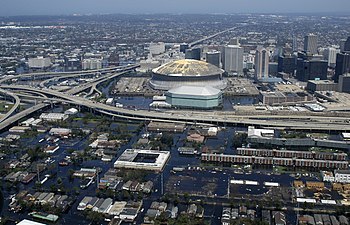
Mistakes at the state and local levels were made primarily before the storm. The most glaring mistake made by the state of Louisiana was its issuance of evacuation orders, but no provision of transportation for the estimated 120,000 poor, elderly, and sick unable to leave the inner city. After the storm struck, governor Kathleen Blanco's (of Louisiana) alleged refusal to give control of the state's National guard troops to the President caused the rampant looting crisis in the city to be firmly her responsibility. She did not commit herself to fighting the looting in the city until September 2, nearly five days after landfall.
But by far, most criticism was directed towards the federal response and the Bush Administration. The American people, aided by angry criticism from the news media, perceived the response as proof that America was woefully unprepared for another disaster, even after the governmental reforms following 9/11. President Bush did not survey the disaster area until August 31, and was criticized by the media for treating the disaster too casually. President Bush is famously quoted as saying "Brownie, you're doing one heck of a job." This was the same day that Michael Brown, head of the Federal Emergency Management Agency (FEMA) and the man he was referring to, told reporters that he and the federal government were unaware of the horrific conditions in the Louisiana Superdome (the primary shelter for those unable to evacuate), even though the news media had been reporting on them for days.
The result of the storm was a realization by the American people that disaster relief agencies were unprepared for what they were created to do. President Bush's approval dropped to its lowest point during his entire presidency, and he was accused of cronyism for hiring unqualified officials to the Department of Homeland Security. Congressional hearings to investigate the matter were to commence in the coming months.
Growing Scandal
[edit | edit source]In addition to complaints of cronyism, a multitude of scandals were brewing in Washington. The CIA Leak scandal ("Plamegate") involved pre-Iraq War intelligence. Joseph C. Wilson, a former diplomat to African countries in previous decades, was recommended by his wife, CIA agent Valerie Plame, to investigate claims that Iraq was buying uranium from Niger. He alleges that he found no connection between the two countries, but President Bush said in his January 2003 State of the Union Address that "The British government has learned that Saddam Hussein recently sought significant quantities of uranium from Africa." That summer, Wilson wrote a column in the New York Times that was highly critical of this remark, and told reporters in several anonymous interviews that the Bush administration was misrepresenting intelligence. A few days after Wilson's column was published, the Washington Post published a column in its paper revealing the identity of the undercover Valerie Plame, thus ruining her career as an agent. Wilson claimed that high officials, namely Karl Rove, the President's chief of staff and a top Republican strategist, leaked her identity to the paper for "retribution" for Wilson's dissent.
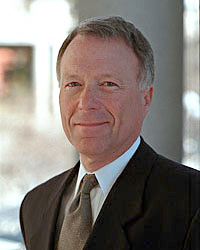
Eventually, an investigation into the matter was opened up. It is illegal for high officials, elected or not, to leak classified information without going through a declassification process. A special prosecutor, Patrick Fitzgerald of Illinois, was appointed to head the investigation. In 2005, he indicted Lewis "Scooter" Libby, Vice President Cheney's chief of staff, for perjury and obstruction of justice in the investigation. Later, Libby testified that he was authorized by White House "superiors" to leak classified info regarding prewar intelligence. The investigation remained ongoing, and many speculated that Fitzgerald was aiming to indict a higher official for the actual investigated offense, leaking Plame's identity, rather than lying to investigators.
Meanwhile, investigations regarding lobbying and political corruption in Congress were ongoing. Jack Abramoff, a top Republican lobbyist, pleaded guilty in early 2006 to three felony charges related to his defrauding of his Native American tribe lobbying clients and tax evasion. He consented to enter a plea bargain in which he agreed to testify in related Congressional corruption investigations in return for a lesser sentence.
Late in 2005, the House Republican leader, Tom Delay, was indicted for conspiracy to violate election law, money laundering, and conspiracy to engage in money laundering. Because of the indictments, Republican house rules forced Delay to temporarily step down as majority leader. A judge threw out the election law violations, but upheld the other charges, causing the rest of Delay's caucus to successfully pressure him to permanently step down as majority leader. Eventually, Delay's heavy association with a litany of scandals forced him to resign from the House in order for his party to retain his congressional seat.
2006 Midterm Elections
[edit | edit source]The Democrats won back the House and the Senate.[8][9] This mid-term election is notable for the fact that no incumbent Democrat vying for a national congressional position was voted from office. The Democratic party gained control of six Senate seats by defeating Republican senators in the states of Montana, Pennsylvania, Missouri, Rhode Island, Ohio, and Virginia.[10] The Democrats gained a 51–49 majority in the Senate House by caucusing with independent senators.[11] The Democratic party gained thirty House seats from the Republican party. This was the first time since the midterm elections of 1994, the Democratic Party gained control of both houses of the United States Congress.
Falling Dollar
[edit | edit source]The U.S. economy and its currency as an instrument of world trade has suffered a series of major setbacks in recent months. Some analysts say that the Federal Reserve's September 18th dramatic rate cut to 4.75% from 5.25% may be a case of "too little, too late", or that it was excessive and dooms the dollar.
On September 20, 2007, Saudi officials declined to cut interest rates in lockstep with the US Federal Reserve for the first time in decades. According to Ambrose Evans-Pritchard, International Business Editor for The Daily Telegraph, "it's a signal that the oil-rich Gulf kingdom is preparing to break the dollar currency peg in a move that risks setting off a stampede out of the dollar across the Middle East."
Hans Redeker, the Currency Chief at BNP Paribas, stated that Saudi Arabia's move to not adjust their own interest rates in sync with the Fed's cuts is a very dangerous situation for the US dollar. Redeker points out that "Saudi Arabia has $800bn (£400bn) in their future generation fund, and the entire region has $3,500bn under management. They face an inflationary threat and do not want to import an interest rate policy set for the recessionary conditions in the United States.
American consumers, meanwhile, stood to be hurt. A drooping dollar means that foreign imports should cost more, from Murano glassware to French candles, to the Middle Eastern oil that powers the boats that bring all this stuff to America.
Advancing Technology
[edit | edit source]Technology in this era saw large refinements, following trends from previous years.
The 2001 antitrust case United States v. Microsoft Corp. was a significant antitrust action, before it was settled.[12]
By the mid 2000's flat screen televisions and monitors became readily available, as had digital video recorders and other advancements in entertainment. Cell phones continued to advance, with many phones adding cameras and additional features during this time. 2007 saw the launch of the iPhone, one of the first smartphones with a minimalist slate deign that found wide market success.[13]
In April of 2003 the Human Genome Project was declared complete, creating a map of the human genome.[14]
NASA's Mars Exploration rovers landed in January 2004, with Spirit working till 2010, and Opportunity continuing to work diligently till 2018, both well past their expected service lives.
The 2004 DARPA Grand Challenge was one of the first major competitions meant to spur the development of autonomous vehicles. Though no vehicles successfully completed the 2004 course, the 2005 course did have winners.
-
Wikipedia in 2001, created by Americans Jimmy Wales and Larry Sanger.
-
An early self driving vehicle from the 2004 DARPA grand challenge.
-
An artist depiction of one of the martian rovers, which landed on Mars in 2004.
-
Mark Zuckerberg in 2005, who had launched Facebook the previous year while studying at Harvard.
-
The first iPhone on display in 2007.
-
Various iPods, popular media players during the 2000's.
References
[edit | edit source]- ↑ "Address Accepting the Presidential Nomination at the Republican National Convention in Philadelphia The American Presidency Project". www.presidency.ucsb.edu. Retrieved 14 December 2020.
- ↑ a b Writer, Dahleen Glanton, Tribune Staff. "HISPANICS TURN FLORIDA INTO MORE OF A SWING STATE". chicagotribune.com. https://www.chicagotribune.com/news/ct-xpm-2000-11-26-0011260457-story.html.
- ↑ "A People and A Nation" the eighth edition
- ↑ Gordon, Philip H. (NaN). "September 11 and American Foreign Policy". Brookings. Retrieved 14 December 2020.
{{cite web}}: Check date values in:|date=(help) - ↑ Bennis, Phyllis. Before and After: U.S. Foreign Policy and the September 11th Crisis. New York. Olive Branch Press. 2003. Print Cole, A. Leonard. The Anthrax Letters. Washington D.C. Joseph Henry Press. 2003. Print Raines, Howell. A New York Times: A Nation Challenged. New York. Callaway. 2002. Print.
- ↑ Nagourney, Adam; Kirkpatrick, David D. (12 July 2004). "THE 2004 CAMPAIGN: SAME-SEX MARRIAGE; Urged by Right, Bush Takes On Gay Marriages (Published 2004)". The New York Times. https://www.nytimes.com/2004/07/12/us/the-2004-campaign-same-sex-marriage-urged-by-right-bush-takes-on-gay-marriages.html.
- ↑ "CNN.com - Bush calls for ban on same-sex marriages - Feb. 25, 2004". www.cnn.com. https://www.cnn.com/2004/ALLPOLITICS/02/24/elec04.prez.bush.marriage/.
- ↑ Hulse, Carl (8 November 2006). "On Wave of Voter Unrest, Democrats Take Control of House". The New York Times. https://www.nytimes.com/2006/11/08/us/politics/08house.html. Retrieved 22 September 2020.
- ↑ Broder, John M. (10 November 2006). "Democrats Gain Senate and New Influence". The New York Times. https://www.nytimes.com/2006/11/10/us/politics/10elect.html. Retrieved 22 September 2020.
- ↑ Kuhnhenn, Jim (9 November 2006). "Democrats Win Control of Congress". The Washington Post. The Associated Press. https://www.washingtonpost.com/wp-dyn/content/article/2006/11/09/AR2006110900147.html. Retrieved 22 September 2020.
- ↑ Engber, Daniel (27 October 2006). "Is Joe Lieberman still a Democrat?" (in en). Slate Magazine. https://slate.com/news-and-politics/2006/10/is-joe-lieberman-still-a-democrat.html. Retrieved 22 September 2020.
- ↑ "Microsoft case in brief". money.cnn.com. November 1st, 2001. https://money.cnn.com/2001/11/01/news/microsoft_chronology/.
- ↑ "LOOKING AT IPHONE WITH REVOLUTIONARY EYES". Retrieved 14 December 2020.
- ↑ "International Consortium Completes Human Genome Project". Genome.gov. Retrieved 14 December 2020.














